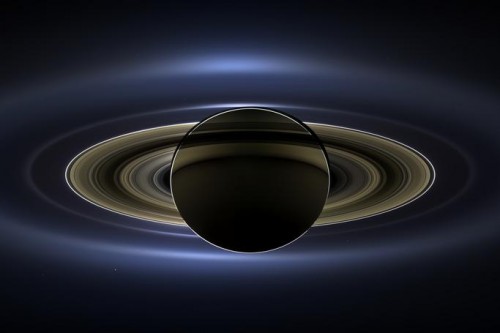
The Cassini mission to Saturn has been one of the most successful and exciting in all of space exploration history. That amazing spacecraft is now celebrating its 10th anniversary today orbiting the ringed planet, after having revolutionized our understanding of the Saturnian system, which is like another entire smaller-scale solar system. But there is still much more to come!
As Linda Spilker, Cassini project scientist at NASA’s Jet Propulsion Laboratory in Pasadena, Calif., summarized:
“Having a healthy, long-lived spacecraft at Saturn has afforded us a precious opportunity. By having a decade there with Cassini, we have been privileged to witness never-before-seen events that are changing our understanding of how planetary systems form and what conditions might lead to habitats for life.”
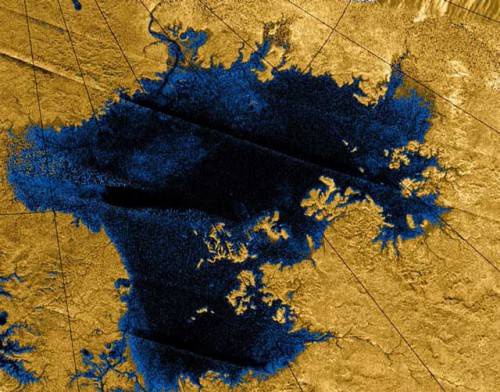
Cassini first arrived at Saturn on June 30, 2004. While the primary mission was slated to be four years, Cassini has enjoyed three mission extensions so far since 2008. This has allowed scientists an unprecedented opportunity to study Saturn and its rings and dozens of moons as never before, revealing many surprises, some of which may even have implications for extraterrestrial life.
Cassini has been able to observe seasonal changes on Saturn, even though the distant planet takes nearly 30 years to orbit the Sun. This is a good reminder of how far away Saturn is, and how incredible it is that there has been a spacecraft from Earth orbiting it for the past decade.
The amount of information Cassini has sent back is staggering; there is a long list of discoveries and accomplishments, including:
– The Huygens probe makes first landing on a moon in the outer solar system (Titan)
– Discovery of active, icy plumes on the Saturnian moon Enceladus
– Saturn’s rings revealed as active and dynamic, a laboratory for how planets form
– Titan revealed as an Earth-like world with rain, rivers, lakes, and seas
– Studies of Saturn’s great northern storm of 2010-2011
– Studies reveal radio-wave patterns are not tied to Saturn’s interior rotation, as previously thought
– Vertical structures in the rings imaged for the first time
– Study of prebiotic chemistry on Titan
– Mystery of the dual, bright-dark surface of the moon Iapetus solved
– First complete view of the north polar hexagon and discovery of giant hurricanes at both of Saturn’s poles
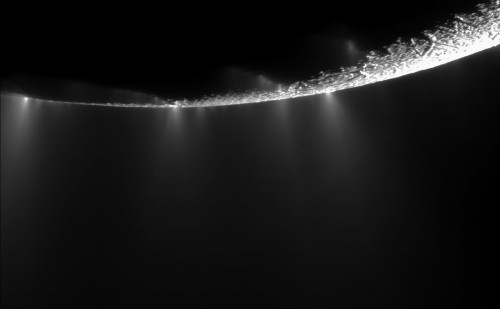
This list is a condensed summary of the most interesting things that Cassini has discovered and observed so far. As Spilker noted, “It’s incredibly difficult to sum up 10 extraordinary years of discovery in a short list, but it’s an interesting exercise to think about what the mission will be best remembered for many years in the future.” More information about these discoveries is available here.
Being so far from the Sun, it was previously thought that most of Saturn’s moons would be largely inactive and geologically dead, little more than frozen ice balls. Titan might be an exception to that, with its known atmosphere and hypothesized oceans of methane. What Cassini found, however, is that some of these moons are actually incredibly active—little Enceladus with its towering plumes of water vapor coming from a sea or ocean of underground liquid water for example. Enceladus is now a high-priority target in the search for evidence of like beyond Earth, now ranking up there with Jupiter’s ocean moon Europa. Titan didn’t have methane oceans, but it does have methane/ethane seas, lakes, rivers, and rain. There may also be a water ocean beneath Titan’s surface. The Huygens probe, released from Cassini, was the first robotic probe to land on Titan, or any other outer Solar System moon. The ground it landed on, in an older dried-up methane streambed, was still damp.
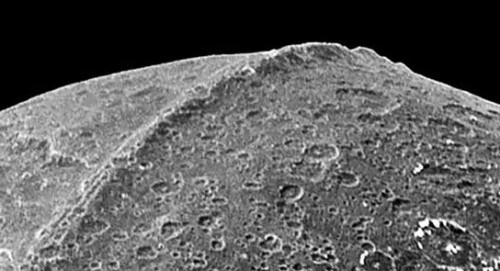
Iapetus, a small rocky and icy moon, has an intriguing narrow ridge which wraps around most of the equator, making the moon look like a walnut.
The atmosphere and rings of Saturn itself are very active and dynamic as well. The hexagon-shaped band of clouds around Saturn’s north pole is one of the most unique features in the Solar System, with a hurricane-like storm in the middle of it. The rings are like a miniature solar system-in-the-making, reminiscent of how the planets are thought to have formed from similar disks or rings of debris orbiting the young Sun billions of years ago. While incredibly thin and flat relative to their size, the rings contain unusual vertical structures, like pointy hills, which were photographed for the first time by Cassini.
If you look at Cassini’s accomplishments in terms of numbers, they are truly impressive:
– 2 billion miles traveled since arrival
– 206 orbits completed so far
– 132 close flybys
– 332,000 images taken so far
– 7 new moons discovered
– 514 GB of data collected so far
– 2 million commands executed so far
– 291 engine burns so far
– 3,039 science papers published so far
– scientists from 26 nations participating
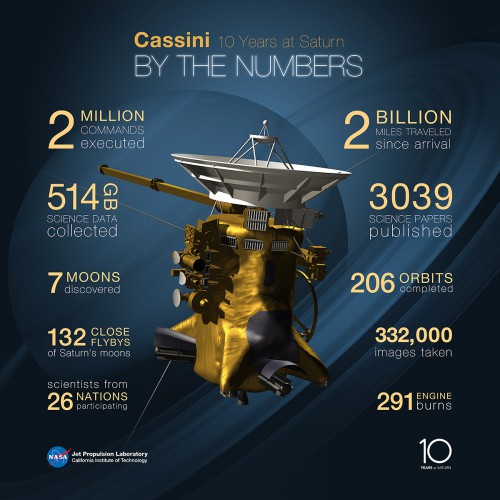
There is also a gallery of favorite images, chosen by the Cassini team, available here.
As for the future, Cassini is still in excellent health and expected to continue for several more years, at least until 2017, lots of time to make yet more discoveries. “Our team has done a fantastic job optimizing trajectories to save propellant, and we’ve learned to operate the spacecraft to get the most out of it that we possibly can,” said Earl Maize, Cassini project manager at JPL. “We’re proud to celebrate a decade of exploring Saturn, and we look forward to many discoveries still to come.”
There is an excellent video, “Cassini: Coming Attractions at Saturn,” here, which gives an overview of what is yet to come in this exciting mission, including looking for more evidence of waves on Titan’s seas and lakes, flying through Enceladus’ water vapor plumes when they are at their maximum output, and further monitoring the seasonal changes on Saturn itself. Even the projected end of the mission, when the propellant in the tanks finally runs out, will be stunning, as Cassini dives through the gap between the innermost D ring and upper atmosphere of Saturn, before plunging into the atmosphere itself. There are also proposals to send a return mission to Titan to further explore its seas and lakes, possibly even a “boat-type” lander at some point, but probably an orbiter or balloon kind of probe before then.
Until then, we can expect Cassini to continue to send back images and data which will further increase our knowledge of this wondrous place.
Want to keep up-to-date with all things space? Be sure to “Like” AmericaSpace on Facebook and follow us on Twitter:@AmericaSpace





Future space historians will look at the Cassini mission as the most significant achievement in planetary exploration during the 21st century. It will forever stand as a testament to human ingenuity. The “numbers” speak for themselves – astounding!